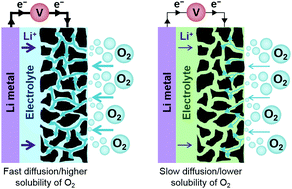Oxygen solubility and transport in Li–air battery electrolytes: establishing criteria and strategies for electrolyte design†
Abstract
Li–air or Li–oxygen batteries promise significantly higher energies than existing commercial battery technologies, yet their development has been hindered by a lack of suitable electrolytes. In this article, we evaluate the physical properties of varied electrolyte compositions to form generalized criteria for electrolyte design. We show that oxygen transport through non-aqueous electrolytes has a critical impact on the discharge rate and capacity of Li–air batteries. Through experiments and molecular dynamics simulations, we highlight that the choice of salt species and concentration have an outsized influence on oxygen solubility, while solvent choice is the major influence on oxygen diffusivity. The stability of superoxide reaction intermediates, key to the oxygen reduction mechanism, is also affected by variations in salt concentration and the choice of solvent. The importance of reactant transport is confirmed through Li–air cell discharge, which demonstrates good agreement between the observed and calculated mass transport-limited currents. These results showcase the impact of electrolyte composition on transport in metal–air batteries and provide guiding principles and simulation-based tools for future electrolyte design.



 Please wait while we load your content...
Please wait while we load your content...